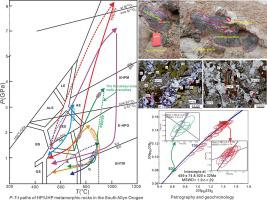Journal of Asian Earth Sciences ( IF 2.7 ) Pub Date : 2021-03-29 , DOI: 10.1016/j.jseaes.2021.104766 Xin Li , Liang Liu , XiaoYing Liao , YongSheng Gai , Tuo Ma , GuoJian Geng , Tong Li

|
The South Altyn high-pressure–ultrahigh-pressure (HP–UHP) metamorphic belt in West China records the processes of deep continental subduction (>150–300 km). The HP mafic granulite pods hosted by massive granitic gneiss were for the first time discovered in the Kuruksayi area of the South Altyn Orogen, and they consist mainly of garnet, clinopyroxene, plagioclase, hornblende, biotite, and quartz, with minor rutile, ilmenite, and K-feldspar. The garnets vary in grain size and chemical zoning, and can be divided into three types: subhedral porphyroblastic (g1), anhedral porphyroblastic (g2), and neoblastic fine (g3) grains. Four generations of mineral assemblage (M1–M4) are recognized, and are used to constrain the P–T evolution of the mafic granulites using phase equilibria modeling calculated by THERMOCALC. The first generation (M1) is represented by the core domains of g1 (g1C) that have inclusions of rutile and quartz and conspicuous chemical zoning. A pre-peak prograde stage of metamorphism from ~ 15.8 kbar/600 °C to ~ 19.2 kbar/655 °C is recorded by g1C. The second generation (M2) is inferred to consist of garnet + omphacite + phengite + rutile + quartz and is recorded in the mantle domains of g1 (g1M). Modeling suggests that this is representative of conditions that reached a maximum P–T of ~ 36.2 kbar/920 °C. The third generation (M3) is characterized by intergrowths of clinopyroxene + plagioclase and biotite + plagioclase, and this stage is recorded by the compositions of g2 with modeling suggesting an evolution from ~ 17.8 kbar/820 °C to ~ 11.5 kbar/826 °C, consistent with near-isothermal decompression. The last generation (M4) is characterized by kelyphitic rims of plagioclase + hornblende around garnet and the hornblende coronas that encompass symplectitic clinopyroxene, and is recorded by the compositions of g3. Modeling suggests evolution from ~ 11.5 kbar/826 °C to ~ 8.7 kbar/735 °C, compatible with near-isobaric cooling. These four stages of metamorphism together establish a clockwise P–T path, which indicates a series of tectonic processes that took the continental slab from subduction to exhumation. Zircon U–Pb dating by LA–ICP–MS yielded two distinct clusters of ages: c. 897 Ma magmatic protolith ages and c. 494 Ma metamorphic ages. The metamorphic ages are interpreted to represent the timing of the eclogite-facies metamorphism, and are similar to the metamorphic ages of other HP/UHP rocks elsewhere in the South Altyn Orogen. Accordingly, we propose that the Kuruksayi mafic granulites underwent UHP metamorphism similar to that recorded in other South Altyn eclogites exposed in Jianggalesayi and Danshuiquan to the west and Yinggelisayi to the east.











































 京公网安备 11010802027423号
京公网安备 11010802027423号